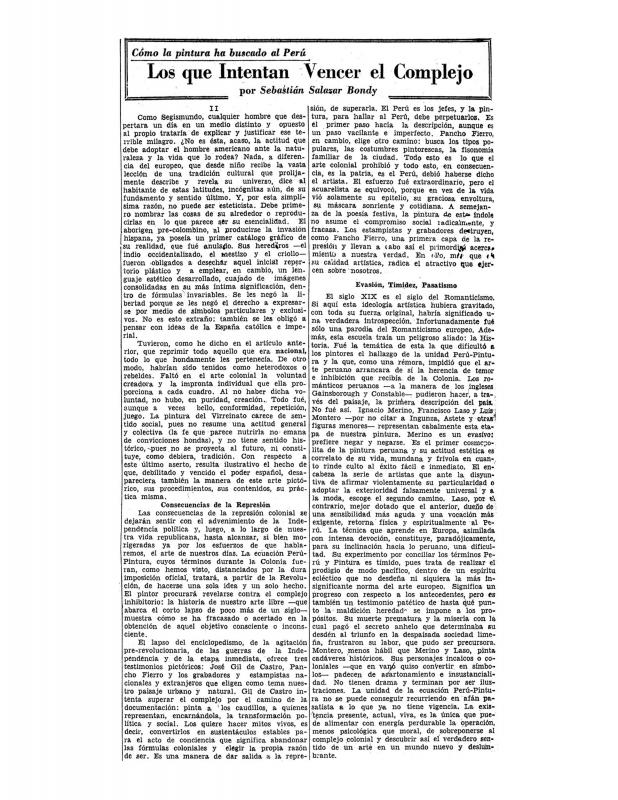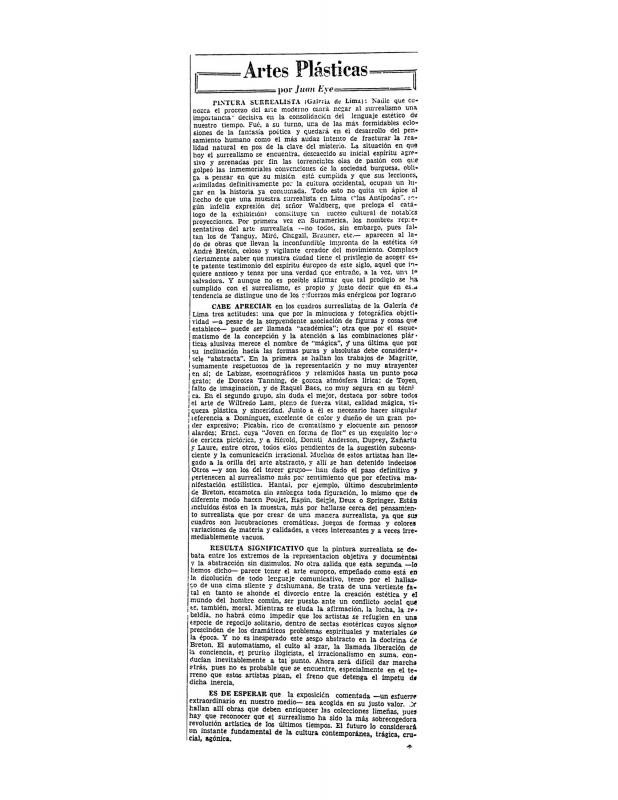This text is the third and final part of an essay that caused a polemic around the nation. In it, Sebastián Salazar Bondy formulates a form of essentialism on the basis of the “Peru-painting” equation in which painting is not seen as “an aesthetic theory,” but rather “a sociological interrogation” that, in some way, sheds light on the Andean nation’s culture and art. In the author’s view, the post-romantic generation—represented by painters Daniel Hernández (1856–1932), Teófilo Castillo (1857–1922), and Carlos Baca-Flor (1867–1941)— is not essential to Peruvian art history because it is anachronistic.
In a lecture entitled “Cómo la pintura ha buscado al Perú” delivered on September 12, 1955, writer Sebastián Salazar Bondy (1924–65) provided a historical overview on the basis of the “Peru-painting” equation. This text reproduces the third part of that lecture. Architect Miró Quesada Garland—a major framer of modern art and architecture in Peru—formulated one of the most acute questionings of Salazar Bondy’s nationalist discourse, making ironic reference to that equation as a contradictory comparison of terms political and artistic. Salazar Bondy’s response led to an extensive exchange between the two men—one of the culminating debates between the so-called “artepuristas” and supporters of “socially committed art.” Salazar Bondy’s lecture even projected the tensions between “the visual” and “nationalism” onto the past. It suggests his negative opinions of Peruvian colonial art, opinions he would later voice in no uncertain terms in his Lima la horrible (1964)—a book pivotal to the sixties generation.
In the modernist debates over this issue—debates that began in June 1951 with statements by painter Fernando de Szyszlo (b. 1925)—critic Samuel Pérez Barreto (1921–2003) defended earthly abstraction as the only possible means to devise art both “Peruvian” and modern. Despite Pérez Barreto’s position, the terms of the debate that ensued over the course of the fifties pitted “programmatic and figurative nationalism” against an “abstract” language committed solely to art. Indeed, Miró Quesada Garland and Salazar Bondy had clashed in the debate on nationalism in art in mid-1954.
[For further reading on the debates between Peruvian modernists and advocates of socially committed art, see the following articles in the ICAA digital archive: by Fernando de Szyszlo “Dice Fernando Syszlo que no hay pintores en el Perú ni América: el joven pintor peruano declara sentir su pintura y la de los demás pero no puede explicarla” (doc. no. 1137793); and by critic Samuel Pérez Barreto “Pintura: la guerra de los pintores: plumas por pinceles” (doc. no. 1137839), “Arte: la guerra de los pintores” (doc. no. 1137856), and “Polémica: ‘polémica Espacio’” (doc. no. 1137916). See as well writer Sebastián Salazar Bondy’s lecture “Cómo la pintura ha buscado al Perú,” published in three parts (this one and two others), entitled “El arte colonial entendido como represión” (doc. no. 1138058) and “Los que intentan vencer el complejo” (doc. no. 1138075). Other texts by Salazar Bondy pertinent to the debate on nationalism include “En torno al desarraigo” (doc. no. 1138565), “Artes plásticas” (doc. no. 1138582), and “Punto final” (doc. no. 1138231). On the other side of the debate, see the column written by Miró Quesada Garland, the primary framer of modern art in Peru, entitled “En blanca y negra” (doc. no. 1138753), (doc. no. 1138772), (doc. no. 1138599), (doc. no. 1138620), (doc. no. 1138718), and (doc. no. 1138248)].















